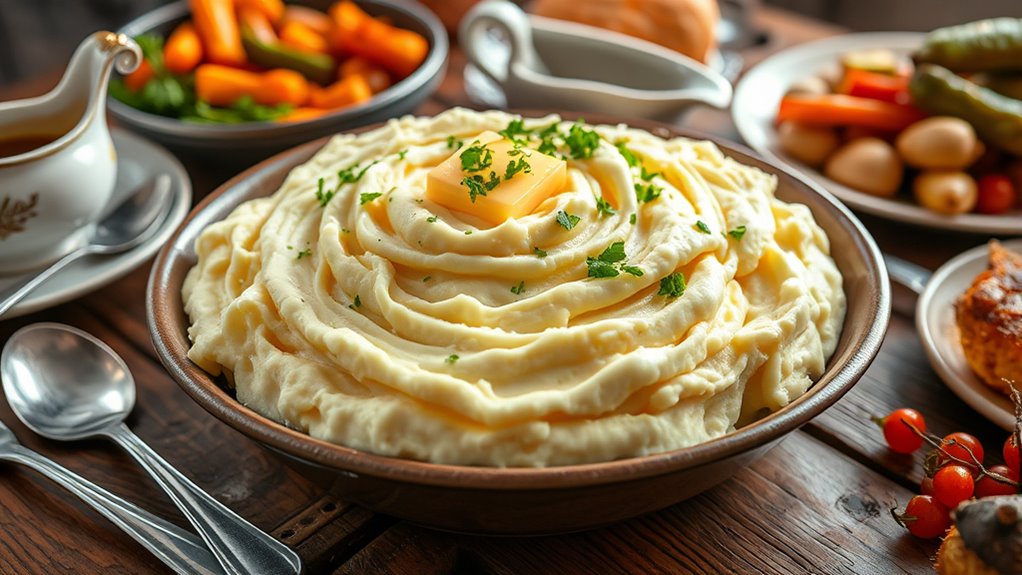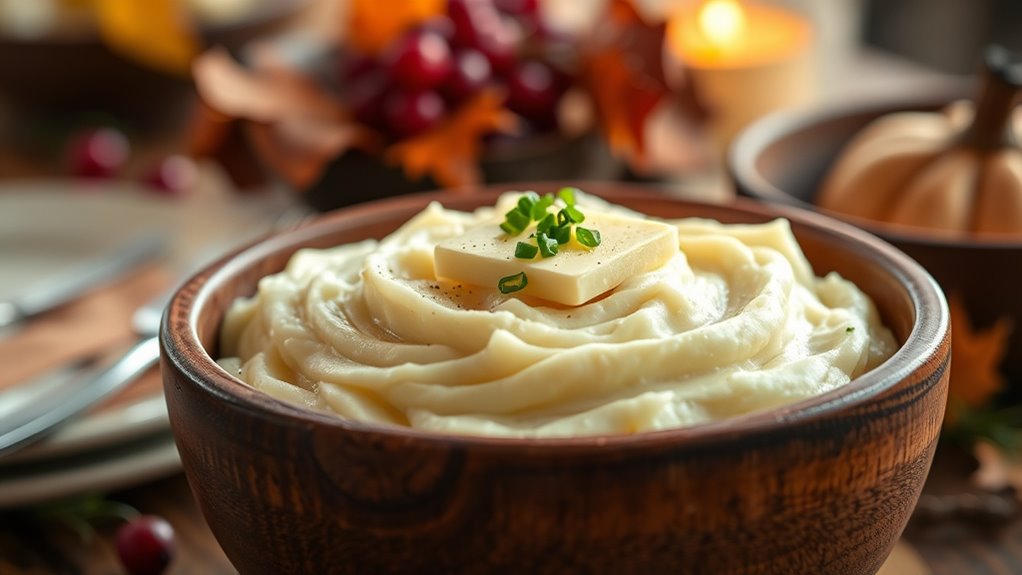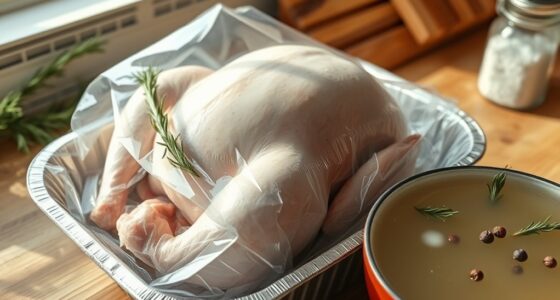To perfect your mashed potatoes for Thanksgiving, choose the right potatoes like Russet or Yukon Gold for ideal texture and flavor. Peel and uniformly cut them, then boil in salted water until tender but not overdone. Drain well and mash while warm, adding plenty of butter and warmed cream or milk for creaminess. Season thoughtfully with salt, pepper, and herbs for enhanced flavor. For expert tips and techniques, keep exploring to elevate your mash to perfection.
Key Takeaways
- Choose a mix of Russet and Yukon Gold potatoes for optimal fluffiness and richness.
- Peel and cut potatoes uniformly, then boil in salted water until tender but not overdone.
- Infuse boiling water with garlic or herbs for added flavor during cooking.
- Mash with warm butter and cream using a ricer or masher for smooth, lump-free texture.
- Finish with fresh herbs, seasoning, and extra butter for a flavorful, creamy Thanksgiving side.

Mashed potatoes might seem simple, but achieving the perfect creamy texture and rich flavor takes a little know-how. The foundation starts with choosing the right potato varieties. Not all potatoes are created equal when it comes to mashing. Russet potatoes, also known as Idaho potatoes, are the classic choice for mashed potatoes. Their high starch content results in a fluffy, light texture that easily absorbs butter and cream. Yukon Golds, on the other hand, are all about flavor. Their naturally buttery taste and smooth, waxy flesh produce a creamier, denser mash that feels indulgent without extra butter. Mixing these varieties can give you a balanced combination of fluffiness and richness, tailored to your preference.
Once you’ve picked your potatoes, the next step is proper preparation. Peel them evenly, then cut into uniform pieces to ensure even cooking. Boil them in salted water until tender—use enough salt to flavor from the inside out. Overcooking can make the potatoes waterlogged, while undercooking leaves lumps and uneven texture. Drain them thoroughly to avoid excess moisture that can make your mash gluey or watery. For flavor enhancements, consider adding whole garlic cloves to the boiling water, infusing subtle aromatic notes into the potatoes. A splash of cream or milk added during mashing will help achieve that luscious, velvety consistency.
When it’s time to mash, use a potato masher or a ricer for the smoothest results. Avoid using a food processor or blender, as these can turn your potatoes gluey. As you mash, incorporate butter generously—this is key to rich flavor and a smooth texture. Warm your cream or milk before adding; cold liquids can cause the potatoes to seize or become lumpy. For added flavor enhancements, stir in freshly chopped herbs like chives or parsley, or a sprinkle of roasted garlic. A dash of freshly cracked black pepper and a pinch of salt will round out the taste.
Frequently Asked Questions
Can I Prepare Mashed Potatoes a Day Ahead?
Yes, you can prepare mashed potatoes a day ahead. For make ahead tips, mash and store them in an airtight container in the fridge. Use storage tips like adding a little butter or cream on top to prevent drying out. When ready to serve, reheat gently on the stove or microwave, stirring in a bit more milk or butter if needed. This way, your mashed potatoes stay fresh and flavorful for Thanksgiving.
What’s the Best Type of Potato for Mashed Potatoes?
The best potato varieties for mashed potatoes are starchy types like Russets or Yukon Golds. They offer a fluffy, creamy texture that’s ideal for mashing. To achieve perfect mashed potatoes, use starchy potatoes and avoid overmixing to keep them light. Yukon Golds have a buttery flavor and smooth texture, making them a great choice. Remember, choosing the right potato variety and following texture tips will give you irresistibly creamy mashed potatoes.
How Do I Prevent Mashed Potatoes From Becoming Gluey?
To prevent mashed potatoes from becoming gluey, choose potatoes with lower starch content like Yukon Golds or red potatoes. Be careful not to overmix; mix just until smooth to avoid releasing excess starch, which causes a gluey texture. Use warm milk or butter for creaminess, and avoid overworking the potatoes. These tips help you achieve fluffy, creamy mashed potatoes perfect for your Thanksgiving feast.
Should I Peel the Potatoes Before Mashing?
Peeling potatoes is like stripping away layers of a mystery—choose your peeling method based on potato varieties. If you want smooth mash, use a vegetable peeler for uniformity. For rustic charm, leave some skin on. Varieties like Yukon Gold or Russet respond differently; Yukon Gold needs less peeling. Peeling before mashing guarantees creaminess and helps avoid gluey texture, making your mashed potatoes irresistibly smooth and flavorful.
What Are Alternative Dairy Options for Mashed Potatoes?
You can try dairy-free substitutions like almond milk, coconut milk, or cashew cream for a creamy texture. Vegan cream options, such as cashew-based or coconut-based creams, work well too. These alternatives add richness without dairy, making your mashed potatoes suitable for vegans or those with lactose intolerance. Just warm the plant-based milk or cream and mix it in gradually until you reach your desired consistency and flavor.
Conclusion
To perfect your mashed potatoes, choose the right potatoes, season them well, and add the right amount of cream and butter. To achieve smoothness, to enhance flavor, to create comfort—these steps transform simple potatoes into a Thanksgiving favorite. Remember, it’s about the details, the patience, and the care you put in. Keep these tips in mind, and you’ll serve mashed potatoes that everyone will remember, everyone will enjoy, everyone will praise.









